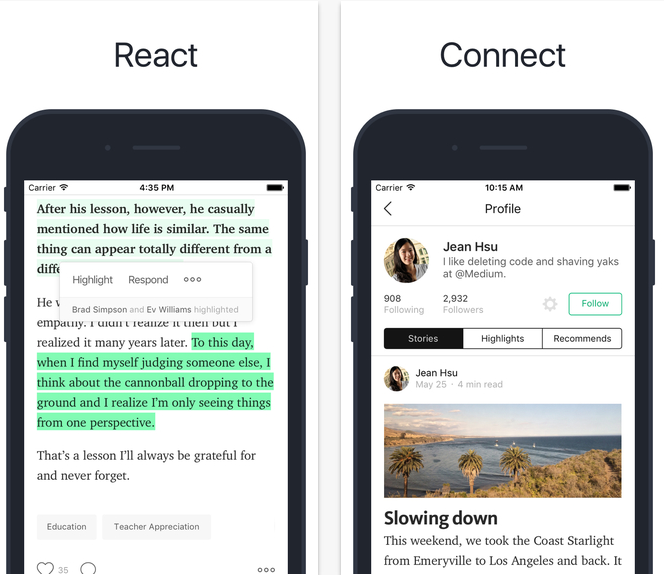SAN FRANCISCO — Publishing site Medium has unveiled a slew of updates today for its iOS and Android app at an event focused on showcasing how to build a sustainable platform. Company chief executive Evan Williams took the opportunity to set the record straight on what his company is all about: moving ideas forward.
In the 45-minute presentation, Williams and his team showcased new tools in the mobile apps around discovery, interacting, and publishing, and what else Medium will do to create a much smarter world. Here’s the tl;dr of the announcements: a form of commenting, better discovery, a publishing API, the ability to migrate your content to Medium without sacrificing your URL, and eventually a way to monetize your work.
Interacting on Medium
When it comes to interaction, product manager Brian Ellin said, most people are probably consuming content from the mobile app. Some of the updates to the company’s iOS and Android apps available now include deep linking (just type in the @ symbol and you’ll be able to reference other content on Medium), support for 3D Touch, syncing of stories and drafts, new typography, enhanced ways to interact, better profiles that show you what people have highlighted and recommended, and features to surface top stories and other recommendations.
In addition, responses have been added that provide the equivalent of commenting. Instead of adding discussions at the bottom, readers can respond to any quote. Once compiled, the original post will have a denotation that shows somebody responded. If you see an asterisk-like symbol, you can just tap on it to show you the response from your reader — you can then respond in context to add some insights. “When you know that it’s going to show up in context, it’s going to be easier to compose a response,” said Williams.
Other updates include better notifications as well as new communication tools that let readers chat directly with an author.
The new version of Medium’s iOS and Android apps are rolling out now.
Discovering by exploring
But being able to compose content isn’t enough — Medium is also about discovering new ideas. To that end, Medium is further leveraging tagging and a recommendation algorithm. The company says that 80 percent of stories are now tagged, and those that have one or more keyword tagged are at least three times more likely to be read. You can even follow specific tags, with some having thousands of followers.
Starting today, Medium has added an Explore feature. In addition to displaying top stories and the tagged stories you’re interested in, Medium will also promote interesting authors, stories deemed to be conversation starters, those that have lots of responses, and of course recommendations curated by Medium’s staff.
Getting it out there by publishing
The last piece of the Medium puzzle is helping publishers get their work on Medium. Katie Zhu, who works on engineering and product at Medium, said that organizations are turning to her team for help on getting content on the platform. There are those that have built an audience on Medium just like they would with a standalone website — something that’s proven to be a powerful tool for those wanting to get their ideas shared.
To date, there are 1,500 active publishers on Medium, including The Synapse and Those People, and Zhu said these publications are garnering hundreds of thousands of readers each month. And brands are paying attention: Now The Awl, Discovery Communications, Fusion, How We Get To Next by Steven Johnson, Mic, MSNBC, and Travel + Leisure have joined as content partners.
In order to facilitate more publisher interest, starting today Medium has partnered with NameCheap to help content creators move their content over to its platform without giving up their web address. This follows along with the launch earlier this year of support for custom domains.
Additionally, a publishing API has been made available for people to easily share their content using OAuth2 for authentication. Zhu says that while Medium has built a great tool for writing, it’s not the main value — the main value is the publishing network. Through this API, content creators can share their story on the platform from anywhere. The API supports Markdown and HTML content formats, canonical URLs for cross-posting, and the full range of licenses available on Medium.
The API will be available in limited early access today with plans to open it to the public in the future.
Also announced today, Ulysses and iWriter are enabling their users to port content over to Medium. The company also introduced a WordPress plugin, as well as an IFTTT channel designed to help publishers create their own interactions with its platform.
In the future, there will be new ways for publishers to monetize their work on Medium, but more details will be revealed later. The company did say that the user experience as well as their users’ needs and rights will be the priority.
A more modern brand
Medium has also debuted a brand new logo and brand. The previous version is reserved, but now it better reflects the modern ideas the company is pursuing.
Rethink publishing
When Medium first came onto the scene, many thought that it would be akin to the likes of WordPress, Tumblr, LiveJournal, and even Blogger, which Williams created before it was acquired by Google. It wasn’t a service where anyone could just create an account and then blurt out whatever they’re feeling. No, in fact, it was a matter of curating who could really publish.
Williams spoke about the problem that his team set out to solve over the past 16 years, starting back when Blogger was created. “It was a fun side project,” he said. However, “as the Web grew, we realized it (open free publishing) wasn’t just only fun, but potentially important.” It wasn’t just about the content, but about the ideas that were being shared: “What else could make the world a smarter, better world than that?”
“Today, putting stuff out on the Internet today is easy. Our devices are constantly connected and we have a variety of apps to put content out there,” Williams explained. “It’s easy to trivialize all this stuff, but the fact that billions of people have the power of the printing press at their fingertips is a huge idea. It’s a huge advance for society.”
Medium has tried to establish a culture in which people could expect to receive insightful posts about issues instead of what people did that day. Williams has said in the past that the number of people publishing on the site every day is growing, but it’s facing competition from a lot of entities. Will its seamless reading and writing experience across both the web and mobile, along with its interesting take on offering content creators increased exposure, really help it stand out in the crowd?
Playing with house money
The announcement of these product updates and partnerships comes as the company celebrates raising a $57 million series B investment round led by Andreessen Horowitz. This came nearly two years after the last raise of $25 million. Certainly the company isn’t struggling for funds. But now it looks like it wants to begin playing with house money to kick things in high gear.
Launched in 2012, Medium’s original vision was to be a “new place on the Internet where people share ideas and stories.” The company has previously reported that more than 20,000 people were composing content on the platform each week. It has become a place used by people to pen “personal news,” while others have used it to write thoughtful pieces and defend their ideas on how to make the world a better place.
Even brands like BMW have found Medium interesting — in 2014, the car manufacturer became the publishing platform’s first collections sponsor, rolling out paid content.
To date, Medium has only made one acquisition: long-form journalism site Matter. More than a year later, Matter relaunched as a digital magazine.
The publishing industry is an unrelenting monster, and it takes a lot to emerge victorious. Medium has been looking to help push along original content on its site by bringing on board former Wired journalist Steven Levy to create the publication Backchannel. Powered by Medium, Levy’s team has covered a wide range of topics, including about how Steve Jobs “fleeced” Carly Fiorina, Chicago’s use of sensors to improve services, Internet access in Cuba, how Harper Reed became President Obama’s first chief technology officer, and Yahoo CEO Marissa Mayer’s progress.
Other updates include rethinking how people accessed content. Earlier this year, Medium introduced Letters, which delivers blog posts straight to your inbox.
It’s about ‘moving ideas forward’
“Medium is a network that taps the collective intelligence of the audience,” Williams remarked in the beginning of his presentation. The hope is that these updates will enable people to share ideas without encountering the negative feedback loops creators often encounter in the current publishing space.
“Medium is the default place to share perspectives on a number of issues that matter, as increasingly the place to find the best opinion and commentary for what’s happening in the world.”






